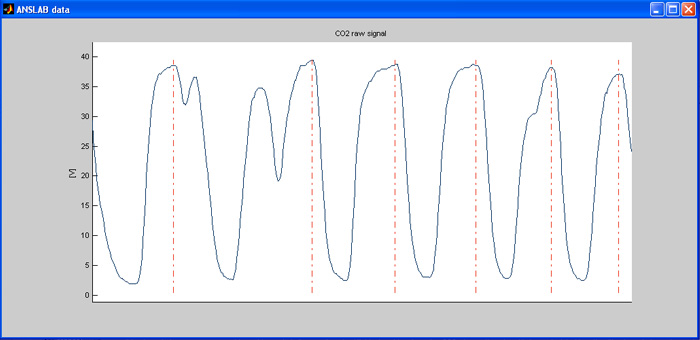
What Does This Channel
Measure?
This channel measures the partial pressure of carbon dioxide (CO2) in
the subject’s expired air (pCO2). Especially relevant is the end-tidal
value at the end of a complete expiration, which corresponds closely to
arterial values at the arterioles deep inside the lung where gas
exchange between outside air and the blood takes place. End-tidal pCO2
(ETPCO2) is the gold-standard non-invasive measure of hypocapnia (low
pCO2) and hypercapnia (high pCO2), corresponding to hyper- and
hypoventilation.
As the first step in the anslab analysis, the end-tidal pCO2 values
over the duration of the file and corresponding breathing
rates are displayed.

Normal healthy baseline values for ETPCO2 are approximately 38 +/- 5
mmHg. Consistently lower values often indicate hyperventilation due to
emotional activation. For editing, you should be mainly concerned with
sudden spikes in the data. Slower, relatively consistent trends in the
data are typically due to changes in the breathing pattern producing
blood gas changes.
What Kind of Artifacts are
Common in this Channel?
The most common problem with ETPCO2 measurement is an incomplete
exhalation through the nose (where the sampling line is attached),
e.g., due to partial breathing through the mouth, speaking, shallow
breathing, or early termination of exhalation. Many values from
instances of these kinds of breaths are automatically excluded by the
program using a strict criterion for a stable end-tidal plateau of
expired pCO2. Only values from such plateaus can be assumed to
approximate gas exchange levels at the arterioles. The end-tidal level
of a shallow or interrupted expiration will mostly reflect levels of
pCO2 in the dead space or upper parts of the lung. Plateaus from such
breaths are typically not flat enough to reach criterion. The same
applies to many end-tidal levels of speech breaths, which are also
typically excluded automatically. However, some of such invalid breaths
might not be screened out automatically and will then occur
intermittently in the end-tidal pCO2 display as easily discernible
spikes.
However, a prolonged series of very shallow breaths might appear as a
rather stable period of low ETPCO2, and needs to be judged in the
context of the results of the respiratory pattern analysis.
How Are Artifacts Removed?
The suspicious intervals should be marked using the  define
segments -button. After zooming to this interval and
switching
to 'raw'-data mode, you can see the raw CO2 signal
with vertical red lines indicating points where the end-tidal
plateaus met the stability criterion of the detection algorithm.
You can either add or delete points using the
define
segments -button. After zooming to this interval and
switching
to 'raw'-data mode, you can see the raw CO2 signal
with vertical red lines indicating points where the end-tidal
plateaus met the stability criterion of the detection algorithm.
You can either add or delete points using the  delete- and the
delete- and the  insert-button in the
editing-section of anslab command window, or you can drag-and-drop
present markers to adjust their position. Most sudden drops in pCO2 of
more than 4 mmHg in one isolated breath without an obvious change in
respiratory rate or pattern preceding or following that breath (e.g.,
sigh, yawn) are invalid and should be excluded.
insert-button in the
editing-section of anslab command window, or you can drag-and-drop
present markers to adjust their position. Most sudden drops in pCO2 of
more than 4 mmHg in one isolated breath without an obvious change in
respiratory rate or pattern preceding or following that breath (e.g.,
sigh, yawn) are invalid and should be excluded.
